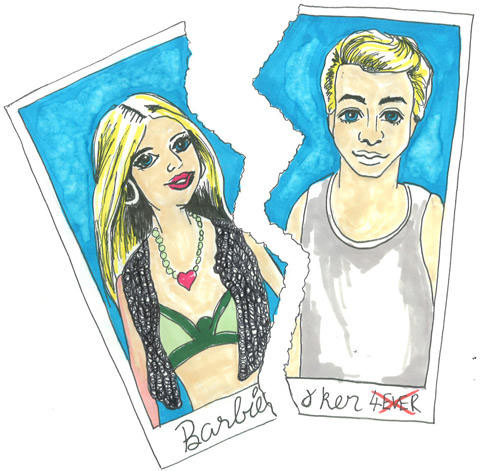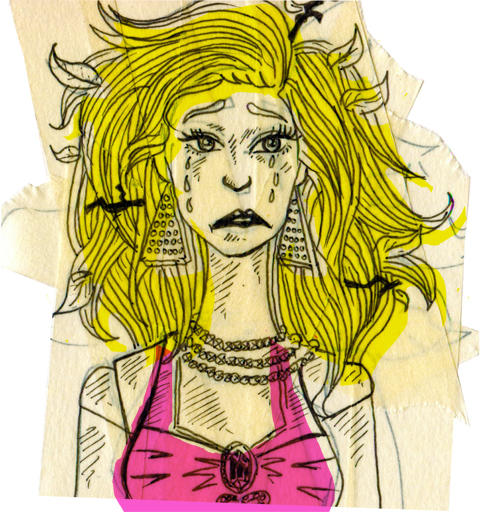
Barbie and Ken by Claire Byrne
Ken dumped Barbie. Over trees and endangered tigers. Seriously. You probably already know this, web since the Greenpeace campaign that first revealed this earth-shattering piece of news has been all over the Internet in the last two weeks.

Barbie Crying by Claire Kearns.
But it’s time to wipe those tears off your keyboard. Not only has this traumatic event turned Ken into quite the eco-warrior and provided some great moments of Twitter comedy, seek but Amelia’s Magazine illustrators have responded, buy information pills providing the greatest collection of illustrations of a chainsaw-wielding Barbie you might ever see in one place.

Barbie with chainsaw by Claire Byrne
Barbie was dumped by Ken after Greenpeace discovered that her maker, Mattel (and other toy companies like Disney), use packaging produced by a company called Asia Pulp and Paper, part of a huge conglomerate called Sinar Mas, accused of major deforestation in Indonesia. This deforestation is pushing critically endangered species like the Sumatran tiger ever further towards extinction.

Barbie Deforrestation by Anna Blachut.
This particular Barbie campaign actually only scratches the surface of an investigation into how global toy manufacturers are complicit in Indonesia’s deforestation problem. Watch this brilliant graphicy animation video for an explanation of Greenpeace’s findings:
It was a wise move to link the broad issue of deforestation in toy packaging and manufacture to the most famous toy (read ‘most mass produced gender-conditioning piece of plastic’) in the world. It even topped Creative Review’s ‘Nice Work’ list for advertising on the 10th of June. It’s a shame Ken hasn’t embraced his inner rebel enough to more openly blame Mattel rather than his ex over this, but I suppose that’s the job of Greenpeace. Ken is still finding his voice, as his heart wrenching twitter updates show, and I have a feeling he’s gradually unleashing the hitherto dormant revolutionary within. Equally shameful is the fact that the feminist within me finds images of Barbie wielding a tool instead of a handbag strangely satisfying. Let’s just hope that Barbie sees the light, joins Ken and decides to become an eco feminist or something asap.

Barbie by Karla Perez.
The fact that we live on a planet where rainforest destruction and species extinction is contributed to in even the smallest way by the packaging for a plastic toy is, quite frankly, weird. How did it come to this? Despite a huge movement to increase our awareness of the environmental impact of fashion and food, toys haven’t been touched upon with the same momentum. And yet toys are associated with our most formative years, so an awareness of what goes into their production is essential.

Barbie by Liz Rowland.
One of my all-time favourite books is Mythologies by Roland Barthes. It was included in the Guardian’s recent 100 Greatest Non Fiction Books list last week, one of only three chosen for the culture category. It investigates the hidden political, economic and cultural ideologies behind everyday aspects of mass culture – from washing powder, to the burlesque dancer, to cars, wine, cheese and plastic.

Barbie logging truck by Claire Byrne.
My favourite essay is the one on Toys, where Barthes explores our increasing obsession with plastic toys, as opposed to simple constructions and tools made of natural materials.

Barbie by Novemto Komo.
The way I understand it, right from childhood we are taken further and further away from the process of making and creating. From day one we’re encouraged to be mindless consumers of complex finished products, emotionally and physically removed from how they were made, who made them and where the materials came from.

Barbie by Zofia Walczak.
This is something we could easily continue into adulthood, through the dreamy lifestyle mythologies in fashion and technology advertising. To me this Barbie campaign is an attention-grabbing antidote to this broader cultural issue, as well as a solid evidence-based environmental campaign.
You can check the Greenpeace UK blog for various ways to get involved, the latest of which involves rating and reviewing Barbie’s ‘dirty deforestation habits’ on Amazon (brilliant, do it!).
Categories ,Anna Blachut, ,Asia Pulp and Paper, ,Barbie, ,Claire Byrne, ,Claire Kearns, ,Creative Review, ,deforestation, ,Disney, ,Greenpeace, ,Guardian, ,Illegal, ,Indonesia, ,Karla Perez, ,Ken, ,Liz Rowland, ,Mattel, ,Mythologies, ,Novemto Komo, ,Plastic, ,rainforest, ,Roland Barthes, ,SInar Mas, ,Sumatran Tiger, ,Toys
Similar Posts:
- Calling all American visual artists, photographers, filmmakers, poets and musicians
- The possibilities of bamboo
- Barbie’s Eighties Elite
- LFW 09 – James Long S/S 2010 – Environmental Disaster Chic
- The Great Fashion Cycle





